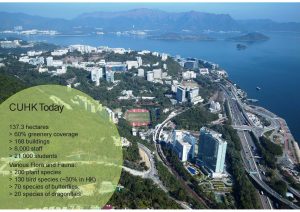
Project Description:
Found in 1963, The Chinese University of Hong Kong (CUHK) has developed from a student population of about 3,000 to 21,000 in 2019. The campus looks like a small town / community whereabout 30,000 staff / students work, study and live. In the course of development, the Campus Master Plan (CMP) has provided an exemplary sustainable framework to balance the growth of the University in achieving teaching and research excellence under her unique college system and campus environment. The CMP consists of six key planning precepts:
- Making a Sustainable Campus
- Places for Education and Research Activities
- Enhancing College Life
- A Pedestrian Friendly Campus
- Conserving Places of Value
- A Landscape of Vital Importance
What is the policy, vision, or objective of the town? Please specify the actual goal and its metrics, if applicable.
The mission and vision of CUHK :
To assist in the preservation, creation, application and dissemination of knowledge by teaching, research and public service in a comprehensive range of disciplines, thereby serving the needs and enhancing the well-being of the citizens of Hong Kong, China as a whole, and the wider world community; and
To be acknowledged locally, nationally and internationally as a first-class comprehensive research university whose bilingual and multicultural dimensions of student education, scholarly output and contribution to the community consistently meet standards of excellence.
Brief outline of the low carbon town development plan
Please refer to the attachment.
Estimated cost savings in implementing low-carbon measures (per year/per unit of energy, etc.)
Break down by Activity/Sector, potential source, estimated savings :
About 10% (saving 90 million MJ) with reference to base year 2013 on campus.
What central/local government departments are/will be involved in development of the project?
University Grants Committee of the Government.
How is/will be the development of the town funded?
Projects are funded by the University Grants Committee of the Government or by private funding.
Managing Organization:
The Chinese University of Hong Kong
LCMT Project Status:
Submitted For Review
Coverage Rate of Population with Access to Tap Water (%):
100%
Coverage Rate of Population with Access to Gas (%):
100%
Power Plant Capacity (GW):
Electricity supply by City’s Power Supply Company
Number of Public Transporation Vehicles per 10,000 Population:
15 nos.
Popularization Rate of Telephone, including Mobile Telephone (sets/100 persons):
Fixed telecom/telephone line to all user’s areas, WiFi for most communal areas and hostel areas.
Per Capita Area of Paved Roads (m^2):
150,600 m^2
Per Capita Area of Public Green Space (m^2):
810,000 m^2
Climate Conditions:
humid, warm and sunny in four seasons.
Expected demographic changes:
No significant increase in following years.
Other expected development:
4 nos. of New Teaching and Research Building to be completed before 2025. 6 no. of New Student Hostels to be completed progressively before 2027. A medical building to be completed by 2020. A student Community Complex to be completed by 2021.
Current stage of development of the town:
Already Existing
Does your low carbon town or development plan have CO2 emission reduction target?:
Yes
Urban Functions:
Compact city design, Efficient road arrangement plan, Well developed public transportation, Plan for highly efficient infrastructure
Transport Sector:
Electric vehicle, Electric busses, LED street lighting, Other
Residential Sector:
Eco-friendly home appliances, PV panel, Solar heated water supply facilities, Use of natural light, Home Energy Management System (HEMS), Other
Commercial Sector:
High insulation/highly airtight materials, Sun shading system, High-performance facade, Roof greening, Highly efficient air conditioning facilities, LED/Inverter lighting, Use of natural light, Building Energy Management System (BEMS)
Renewable Energy:
PV power generation, Solar thermal utilization, Wind power generation
Untapped Energy:
Use of sea/river water, Use of waste heat such as sewage treatment plants
Demand and Supply Side Measures:
Advanced metering systems, Area Energy Management System (AEMS)
